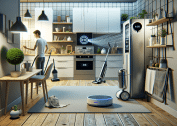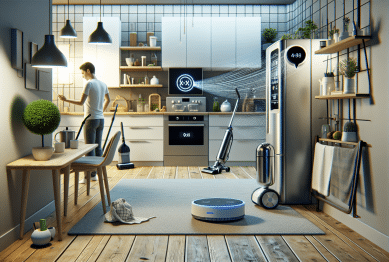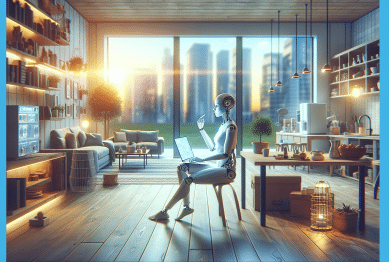Discover the ways smart home technology is quietly revolutionizing daily life. From security systems to energy-saving automation, explore how intelligent devices and connected ecosystems make homes more comfortable, efficient, and enjoyable for a wide range of lifestyles.
Understanding What Makes a Home ‘Smart’
Smart homes blend cutting-edge technology with household routines, creating living spaces that adapt and respond to people’s needs. At the heart of this trend lies home automation, where gadgets like smart thermostats, lighting, and voice assistants communicate through unified platforms. This means everyday appliances can work together to enhance comfort, safety, and convenience. A smart home often features interconnected systems managed via smartphones or voice commands, bringing intuitive control right to your fingertips. With Wi-Fi and sensors, nearly every aspect of the house can be automated.
The concept of home automation has evolved quickly in recent years, thanks to rapid advances in artificial intelligence and the growing Internet of Things (IoT). Devices such as smart doorbells, intelligent lighting, and connected kitchen appliances illustrate how integrated technology makes daily tasks far more manageable. Not only do these innovations simplify routines, but they can also adapt to schedule changes or new preferences. Many systems are crafted to be user-friendly, so even those who aren’t tech-savvy can benefit from their presence.
Smart home technology thrives on interoperability. Different manufacturers focus on making their devices compatible with the most popular digital assistants—think Google Assistant or Amazon Alexa. This cross-platform approach ensures users are not locked into one ecosystem. The growing adoption of standard protocols and frequent updates push the industry toward seamless experiences, meaning more homes can take advantage of the latest smart solutions without unnecessary complexity.
Daily Convenience: The Real Value of Smart Home Devices
One of the main reasons people invest in smart home technology is simple: everyday life feels easier. Imagine waking up to gentle light that mimics the sunrise or having your thermostat automatically set the perfect morning temperature. With connected coffee makers brewing your first cup as you rise, automation brings luxury to even the simplest routines. Seamlessly scheduled lighting or adaptive music choices can boost moods and help regulate sleep cycles. These are just a few examples of how technology subtly supports well-being at home.
For those who juggle hectic schedules or family demands, smart devices can provide peace of mind. Automated reminders can prompt tasks like feeding pets or locking doors. Integrated cameras offer real-time alerts, allowing users to monitor front doors, garages, or nurseries on their phones regardless of location. The ability to check whether appliances are off or lights are dimmed fosters a sense of security, ensuring nothing vital gets overlooked during busy days. Customizable routines adapt to the household’s changing needs, proving flexible and invaluable.
Energy management is another huge convenience provided by intelligent home systems. Smart thermostats, for example, learn household patterns and fine-tune heating or cooling for maximum comfort with minimal waste. Lighting controlled by occupancy sensors turns off automatically in empty rooms, saving on electricity bills. Over time, such features reduce unnecessary spending and help conserve resources. By analyzing usage reports, residents gain insights into their daily patterns and can make changes that further improve efficiency and reduce environmental impact.
Home Security: How Technology Is Enhancing Protection
Security has become one of the most valued aspects of modern smart homes. Gone are the days of basic alarm systems; today, high-definition cameras, motion sensors, and smart locks offer real-time monitoring and control from anywhere. For many households, knowing that doors are always secure and being able to receive instant alerts about unexpected activity brings profound reassurance. Some systems even enable owners to watch live video feeds or communicate through two-way audio from their smartphones. This level of connectivity keeps safety a top priority, whether users are home or away.
Another key advancement involves integration with emergency services. Smoke detectors, carbon monoxide alerts, and water leak sensors—connected to the smart ecosystem—can automatically reach out to responders or send critical warnings to homeowners. This proactive approach doesn’t just detect problems; it helps minimize them early, reducing the risk of extensive damage. Families benefit from a tailored set of notifications that suit their lifestyles, choosing between text messages, calls, or automated app alerts to handle different types of risk.
Beyond the physical security, data protection measures have gained importance, too. With the increased use of connected devices, manufacturers focus on privacy safeguards—like encryption and multi-factor authentication. Prioritizing cybersecurity is essential to maintain trust as smart homes grow more complex. Industry standards and ongoing updates further lock down vulnerabilities, helping prevent unauthorized access and keep personal information safe. As technology evolves, so do best practices for combining convenience with robust security at every level.
Saving Money and Energy with Smart Home Automation
Smart home automation not only boosts convenience but also offers significant savings. Intelligent lighting and HVAC systems, when scheduled to run only when needed, help prevent energy waste. Many users find that simply automating heating and cooling based on occupancy patterns can cut utility costs substantially. Timers and smart plugs add another layer of control, allowing household devices to shut off automatically after use. This careful management supports both economic and sustainable goals.
The rise of smart meters and connected appliances adds real-time insights into energy consumption. Residents can monitor and adjust settings from anywhere, optimizing for efficiency without sacrificing comfort. Homeowners often discover hidden energy drains—such as outdated refrigerators or rarely-used electronics—thanks to usage reports generated by their systems. These insights make it easier to prioritize upgrades or change habits for further savings over time.
Renewable energy integration is becoming more mainstream in smart homes. Solar panels, battery storage, and electric vehicle chargers are increasingly linked with home automation hubs. This allows for smarter use of self-generated power and makes it easy to switch between utility and stored energy as needed. These eco-friendly features help future-proof properties, improve resilience in the event of power outages, and make forward-thinking homes more attractive for environmentally minded communities.
Accessibility and Inclusivity: Benefits for Every Household
Smart home technology has made independent living a possibility for more people, regardless of age or ability. Voice-activated systems, smart door openers, and automated lighting remove common barriers for those with mobility challenges. With a few spoken commands or a tap on a mobile device, vital household operations become accessible. This technology also assists caregivers or family members supporting older adults or individuals with special needs, providing peace of mind and extra freedom.
The widening variety of smart home devices reflects growing inclusivity in design. Features like remote medication reminders, fall detection sensors, and visual or vibrating alerts make homes safer and more comfortable for every resident. Compatibility with a broad array of assistive devices encourages customization, empowering households to tailor their systems to specific requirements. This flexibility allows more people to participate in and benefit from the universal convenience provided by smart homes.
Educational resources and training support the adoption of smart technology for diverse populations. Workshops, accessible apps, and clear user manuals help people of all backgrounds build confidence in managing new systems. Manufacturers and advocacy groups collaborate to reduce technical jargon and prioritize intuitive controls, lowering barriers to entry. These ongoing efforts ensure smart homes aren’t limited to the tech-savvy, but offer transformative value to families, seniors, and individuals with different needs.
The Future of Smart Living: Trends to Watch
The smart home landscape is poised for even more innovation. Artificial intelligence is making devices better at predicting user needs, learning from behavior, and creating proactive solutions. Machine learning algorithms will likely personalize experiences further, adjusting home environments without manual direction. New standards in interoperability continue to break down technical hurdles, fostering harmony among devices from many brands. These trends point toward a future where homes are not just automated, but truly intelligent.
5G connectivity and edge computing are facilitating faster, more reliable communications between household devices. This unlocks more powerful applications in real time, like advanced voice recognition or instant video analytics for smart security. The evolution of virtual and augmented reality may soon allow homeowners to interact with digital twins of their living spaces, planning upgrades or identifying maintenance needs before problems arise. The result is smoother integration of technology with the physical world, building more responsive homes.
With growth comes the challenge of balancing innovation with privacy and affordability. Industry leaders and policymakers are working towards stronger standards for protecting user data and ensuring the benefits of smart homes reach all income groups. Community-driven approaches and open-source projects encourage creative solutions for local needs, making the promise of smart living accessible to entire neighborhoods. As these advancements continue, smart home technology will keep shaping the way people experience safety, comfort, and connectivity every day.
References
1. U.S. Department of Energy. (n.d.). Home automation and Smart Homes. Retrieved from https://www.energy.gov/energysaver/smart-home
2. National Institute of Standards and Technology. (n.d.). Framework for Smart Home Devices. Retrieved from https://www.nist.gov/el/intelligent-systems-division-73500/smart-home-project
3. Harvard University. (n.d.). How Smart Homes Might Help. Harvard Health Publishing. Retrieved from https://www.health.harvard.edu/staying-healthy/smart-homes-getting-smarter
4. Federal Trade Commission. (n.d.). Connected Homes and Privacy Risks. Retrieved from https://consumer.ftc.gov/articles/how-protect-your-privacy-connected-home
5. National Renewable Energy Laboratory. (n.d.). Smart Grid and Home Integration. Retrieved from https://www.nrel.gov/grid/der-grid-integration.html
6. AARP Public Policy Institute. (n.d.). Emerging Technologies to Support Aging in Place. Retrieved from https://www.aarp.org/ppi/info-2021/emerging-technologies-to-support-aging-in-place.html









